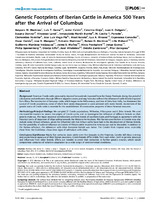Mostrar el registro sencillo del ítem
Genetic Footprints of Iberian Cattle in America 500 Years after the Arrival of Columbus
| dc.contributor.author | Delgado-Bermejo, J.V. | |
| dc.contributor.author | Martínez Martínez, Amparo | |
| dc.contributor.author | Gama, Luis L.T. | |
| dc.contributor.author | Cañón, Javier | |
| dc.contributor.author | Ginja, Catarina | |
| dc.contributor.author | Dunner, Susana | |
| dc.contributor.author | Landi, Vincenzo | |
| dc.contributor.author | Martín-Burriel, I. | |
| dc.contributor.author | Penedo, M. Cecilia T. | |
| dc.contributor.author | Rodellar, Clementina | |
| dc.contributor.author | Vega-Pla, J.L. | |
| dc.contributor.author | Acosta, Atzel | |
| dc.contributor.author | Álvarez, Luz Ángela | |
| dc.contributor.author | Camacho Vallejo, M.E. | |
| dc.contributor.author | Cortés, Oscar | |
| dc.contributor.author | Marques, J.R. | |
| dc.contributor.author | Martínez, Roberto | |
| dc.contributor.author | Martínez, Ruben D. | |
| dc.contributor.author | Melucci, Lilia | |
| dc.contributor.author | Martínez-Velázquez, Guillermo | |
| dc.contributor.author | Muñoz, Jaime E. | |
| dc.contributor.author | Postiglioni, A. | |
| dc.contributor.author | Quiroz, Jorge | |
| dc.contributor.author | Sponenberg, Philip | |
| dc.contributor.author | Uffo, Odalys | |
| dc.contributor.author | Villalobos, Axel | |
| dc.contributor.author | Villalobos, Axel | |
| dc.contributor.author | Zaragoza, P. | |
| dc.date.accessioned | 2012-12-05T09:48:35Z | |
| dc.date.available | 2012-12-05T09:48:35Z | |
| dc.date.issued | 2012 | |
| dc.identifier.uri | http://hdl.handle.net/10396/8378 | |
| dc.description.abstract | Background: American Creole cattle presumably descend from animals imported from the Iberian Peninsula during the period of colonization and settlement, through different migration routes, andmay have also suffered the influence of cattle directly imported from Africa. The introduction of European cattle, which began in the 18th century, and later of Zebu from India, has threatened the survival of Creole populations, some of which have nearly disappeared or were admixed with exotic breeds. Assessment of the genetic status of Creole cattle is essential for the establishment of conservation programs of these historical resources. Methodology/Principal Findings: We sampled 27 Creole populations, 39 Iberian, 9 European and 6 Zebu breeds. We used microsatellite markers to assess the origins of Creole cattle, and to investigate the influence of different breeds on their genetic make-up. The major ancestral contributions are from breeds of southern Spain and Portugal, in agreement with the historical ports of departure of ships sailing towards the Western Hemisphere. This Iberian contribution to Creoles may also include some African influence, given the influential role that African cattle have had in the development of Iberian breeds, but the possibility of a direct influence on Creoles of African cattle imported to America can not be discarded. In addition to the Iberian influence, the admixture with other European breeds was minor. The Creoles from tropical areas, especially those from the Caribbean, show clear signs of admixture with Zebu. Conclusions/Significance: Nearly five centuries since cattle were first brought to the Americas, Creoles still show a strong and predominant signature of their Iberian ancestors. Creole breeds differ widely from each other, both in genetic structure and influences from other breeds. Efforts are needed to avoid their extinction or further genetic erosion, which would compromise centuries of selective adaptation to a wide range of environmental conditions | es_ES |
| dc.format.mimetype | application/pdf | es_ES |
| dc.language.iso | eng | es_ES |
| dc.publisher | Public Library of Science (PLOS) | es_ES |
| dc.rights | https://creativecommons.org/licenses/by/4.0/ | es_ES |
| dc.source | PLoS ONE 7(11) (2012) | es_ES |
| dc.subject | American Creole cattle | es_ES |
| dc.subject | European cattle | es_ES |
| dc.subject | African cattle | es_ES |
| dc.subject | Iberian cattle | es_ES |
| dc.subject | Genetic footprint | es_ES |
| dc.title | Genetic Footprints of Iberian Cattle in America 500 Years after the Arrival of Columbus | es_ES |
| dc.type | info:eu-repo/semantics/article | es_ES |
| dc.relation.projectID | info:eu-repo/grantAgreement/EC/FP7/246542 | es_ES |
| dc.rights.accessRights | info:eu-repo/semantics/openAccess | es_ES |

